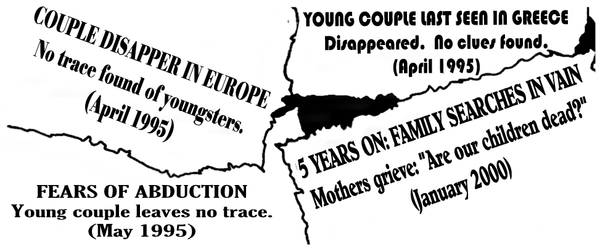| << Chapter < Page | Chapter >> Page > |
| LO 6.1.1 | LO 6.1.3 | LO 6.1.6 |
SPELLING 2: EPONYMS
Eponyms are words that have originated from people’s names or the names of places. Select ten of these words and find out how they came about.
ampere; boycott; Braille; caesarean; cardigan; diesel; dunce; Ferris wheel; guillotine; guy; hooligan; leotard; Levis; mackintosh; Morse code; pasteurise; Pavlova; sandwich; saxophone; teddy; valentine; volts; wellingtons
| LO 6.1.7 |
SPELLING 3
Languages borrow words from one another – explain the meanings of these words and use them appropriately.
| fungus | plateau | radius | |
| chic | sombrero | pasta | yodel |
| chocolate | siesta | lasagne | formula |
List another five words below, taken from other languages.
Note: Use a reliable dictionary to find the country of origin of these words.
| LO 6.1.7 |
SOLVE THIS ONE!
Read the headlines carefully.
These headlines have been printed at regular intervals, all relating to the same mystery.

Prepare a 60 – 90 second talk based on what you believe to be the story behind this mystery.
Use your initiative and touch on the following:
OR
Find a news cartoon (not a comic strip); research the story behind the sketch. Briefly tell the background to the illustration.
| LO 2.1 | LO 2.5.1 | LO 2.5.3 |
SEE IT FROM BOTH SIDES
In your groups discuss the following statement carefully. Try to see the situation from both sides – the reporter’s and the public’s. Allow one person to give feedback to the rest of the class on behalf of your group.
Remember the following about group discussions:
“Newspapers should have the right to publish any news item, irrespective of the damage it may cause.”
| LO 2.4.3 | LO 2.4.7 |
| LO 2 |
| SPEAKINGThe learner will be able to communicate confidently and effectively in spoken language in a wide range of situations. |
| We know this when the learner: |
| 2.1 communicates ideas and feelings expressively with confidence and with some assistance, using selected oral text types (e.g. stories, jokes, dramas); |
| 2.2 communicates ideas, facts and opinions clearly and with some accuracy and coherence, using a limited range of factual oral text types (e.g. discussions, short arguments); |
| 2.3 demonstrates basic skills in selected oral text types: |
| 2.3.3 carries out interviews with peers using simple questions, listening and taking notes carefully; |
| LO 3 |
| READING AND VIEWINGThe learner will be able to read and view for information and enjoyment, and respond critically to the aesthetic, cultural and emotional values in texts. |
| We know this when the learner: |
| 3.2 reads aloud and silently for a variety of purposes using appropriate reading strategies (e.g. skimming and scanning, presictions, contextual clues, inferences); |
| 3.4 shows understanding of information texts: |
| 3.4.1 identifies main ideas and explains how details supprt the main idea; |
| 3.8 responds critically to texts: |
| 3.8.1 identifies writer’s point of view; |
| 3.8.2 identifies implicit (or hidden) messages in the text; |
| 3.8.3 identifies obvious bias or prejudice; |
| 3.8.4 identifies ways in which the writer shapes the reading of the text by careful choice of words; |
| 3.10 reflexts on own skills as a reader. |
| LO 6 |
| LANGUAGE STRUCTURE AND USEThe learner will know and be able to use the sounds, words and grammar of the language to create and interpret texts. |
| We know this when the learner: |
| 6.1 works with words: |
| 6.1.1 uses different strategies to spell unfamiliar words; |
| 6.1.3 uses the dictionary and thesaurus to increase vocabulary and improve spelling; |
| 6.1.6 identifies a range of prefixes and suffixes o work out meaning; |
| 6.1.7 analyses how language borrow words form one another, and how new words are coined and uses these appropriately; |
| 6.2 works with sentences: |
| 6.2.1 identifies and uses nouns, verbs, modals, adjectives, pronouns, prepositions, conjunctions, and articles. |
| 6.4 develops awareness and use of style; |
| 6.4.3 uses idioms and idiomatic expressions of the language appropriately; |
Spelling 1
slippery
Spelling 2
This is a wonderfully exciting task to do. Put the children into groups and give them the task of finding out the origin of, if not 10, then only 1 word. Have a feedback session in order for them to tell what they have found out. Most of the words that they investigate will have a short description or story attached. Makes very interesting reading/listening. The Oxford Complete Wordfinder is a good source of information.
Spelling 3
As for the above exercise.

Notification Switch
Would you like to follow the 'English home language grade 7' conversation and receive update notifications?